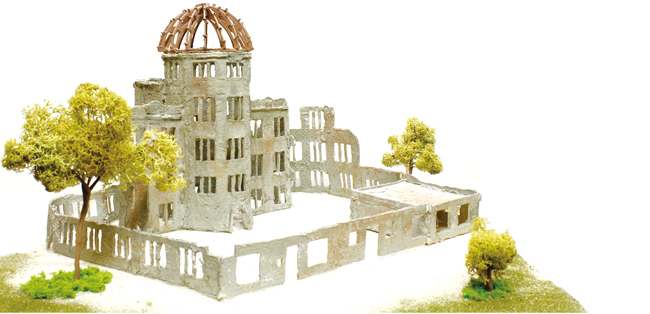
当たり前に日本人として生きてきた。でも海外に出てから、日本について何も知らないことに気が付いた。そこで、日本が世界に誇る世界遺産について建立年順に勉強しようと思う。興味がある人も、そうでない人も、しばしお付き合いを。
I’ve lived my whole life as a Japanese person, but when I went overseas I realised I know practically nothing about Japan. So now I’m learning about Japan’s World Heritage Sites, from oldest to newest. Those who are interested, and even those who are not, come along for the ride.

撮影協力 / メルボルン総領事館 Thanks to the Consulate-General of Japan, Melbourne
○○○○○ 恒久平和の大切さを世界へ訴えるシンボル 原爆ドーム ○○○○○
今回は、1996年に世界文化遺産に登録された、広島県の原爆ドームを紹介します。実は、原爆ドームという呼び名は通称で、正式名称は広島平和記念碑といいます。しかし、原爆ドームのほうがピンとくる人が多いと思うので、このまま通称を使用します。
既に皆さんご存知かと思いますが、原爆ドームは、第2次世界大戦末期に核兵器により被爆した建造物。現在は、核兵器の惨禍を伝え、時代を超えて核兵器の廃絶と、平和の大切さを訴える人類共通の平和記念碑となっています。一般に”人類が犯した悲惨な出来事を伝え、そうした悲劇を二度と起こさないための戒めとなる物件”を指す、『負の世界遺産』と呼ばれていますが、ユネスコが公式に定義・分類している訳ではないようです。ちょっぴり脱線しますが、負の世界遺産と呼ばれるものには、奴隷貿易の拠点となったゴレ島、ナチスによりユダヤ人が虐殺されたアウシュヴィッツ強制収容所など、オーストラリアでは植民地拡大時代に大英帝国によって建てられた囚人遺跡群があります。
話を原爆ドームに戻して。原爆ドームは、チェコの建築家ヤン・レツル氏による設計で、広島県内の物産品の展示・販売をする施設「広島県物産陳列館」として、1915年に元安川沿いに建てられました。中庭のあるヨーロッパ風の建物で、全体は窓の多い3階建て、正面中央部分は5階建ての階段室、その上に銅板の楕円形ドームが載せられました。当時は川面に映えるモダンな美しさから、広島名所のひとつに数えられていました。今はまったく違った意味で広島名所のひとつになっているのが、なんとも皮肉な気がします。その後名称を「広島県立商品陳列所」、1933年には「広島県産業奨励館」に改称。そして、1945年8月6日午前8時15分を迎えます。原子爆弾が炸裂したのは、広島県産業奨励館から南東約160m、高度約600mのところで、建物は爆風と熱線を浴びて大破し、 天井から火を吹いて全焼。爆風がほぼ真上から働いたため、建物の中心部は奇跡的に倒壊を免れたものの、館内にいた30人余りの人々は全員即死したと伝えられています。戦後、頂上の円蓋鉄骨の形から原爆ドームと呼ばれるようになりました。
ドームの保存については、「原爆による惨禍の証人として保存する」という意見と、「危険物であり、被爆の惨事を思い出したくないので取り壊す」という意見が対立しましたが、市街地が復興し、被爆建物が次第に姿を消していく中で、原爆投下をどう考えるか、被爆者や被爆体験などの惨事をどう伝えるか、核兵器をめぐる世界の情勢をどう考えるかなど、議論の重なりを見せ、1966年に広島市が永久保存を決定。同時に広く募金を呼び掛け、国内外での善意の募金により、3回の大規模な保存工事が行われ、現在に至ります。
とても個人的なことですが、数年前に日本に一時帰国した際、広島に行きました。その時は安全保障関連法案の採決を巡り、日本各地で大規模な法案に反対するデモが行われていて、広島滞在中にも小さな法案反対デモに遭遇しました。そのデモは、学生とお年寄りが半々ぐらいで平和を訴えるプラカードを掲げていました。原爆を経験した広島というロケーションからか、他の大規模な法案反対デモよりグッと心に訴えかけてくるものがありました。
今回で最後の『日本にある世界の遺産』ですが、今後も日本に関するアレやコレをお勉強していきたいと思っています。
○○○ Genbaku Dome: A symbol for the world to know the importance of peace ○○○
This time we introduce Hiroshima Prefecture’s Genbaku Dome, which was added to the World Heritage register in 1996. Actually, its proper name is the ‘Hiroshima Heiwa Kinenhi’ (‘Hiroshima Peace Memorial’), but as most people know it as ‘Genbaku Dome’ (‘Atomic Bomb Dome’) I willcall it that throughout this article.
As you may already know, Genbaku Dome is a structure that was hit by an atomic bomb in the final days of the Second World War. It is a present-day reminder of the destructive power of nuclear weapons, carrying through the ages a hope for their abolition and for world peace. It is considered a ‘negative world heritage’ site – a place telling us of a terrible disaster caused by humanity and warning us never to do such things again – but this is not a UNESCO definition or classification. Other negative heritage sites are the Island of Gorée, which was a central base of the slave trade; the Auschwitz concentration camp where the Nazis carried out mass killings of Jews; and the Australian Convict Sites, ruins of penal sites built by the British Empire during its colonial expansionist period.
Genbaku Dome was designed by Czech architect Jan Letzel and built in 1915 as the ‘Hiroshima Prefecture Industrial Products Display Hall’. A European-style building with a courtyard, it had three storeys with numerous windows, with the central front section housing a five-storey stairwell up to a copper-plated oval dome. At the time it was one of Hiroshima’s most famous places for its modern beauty reflected in the river; now, it is famous for an entirely different reason. Its name was later changed to ‘Hiroshima Prefectural Products Exhibition Hall’, and again in 1933 to the ‘Hiroshima Prefectural Industrial Promotion Hall’. Then came the 6th of August, 1945, 8:15am. The atomic bomb exploded only 160m southeast of the hall, at a height of around 600m; the building sustained heavy damage from the blast and the heat rays, and it burned from the ceiling to the ground. Because the blast was almost directly above it, the middle part of the building miraculously did not collapse. However, the 30 people inside were all killed instantly. After the war, the steel-framed dome gave it its new nickname of ‘Genbaku Dome’.
There were opposing opinions regarding preservation of the dome; some said it ought to be preserved as witness to the calamity of the atomic bomb, while others argued that it should be demolished as a hazard and an unwanted reminder of the horrors of the bombing. As the city was rebuilt and the rubble disappeared, arguments piled up over how we should think about the dropping of the A-bomb, about nuclear weapons in the world, and about how to transmit the awful experiences of the victims and survivors. But in 1966, the City of Hiroshima decided to preserve the building permanently. They did extensive fundraising appeals, and thanks to good-willed donations from both in and outside Japan it has undergone large-scale restoration and preservation work three times up to the present day.
On a personal note, I went to Hiroshima when I was back in Japan few years ago. There were demonstrations all over the nation protesting the security bill, and I encountered a small one in Hiroshima. The crowd holding up placards calling for peace was about half students, half elderly. Maybe it was because it was in Hiroshima, which has actually experienced a nuclear bomb, but this one seemed somehow the most moving of all the anti-bill demonstrations.
This has been the final of the articles on Japan’s World Heritage sites, but I hope to keep learning and writing about Japan and its various aspects in future.

